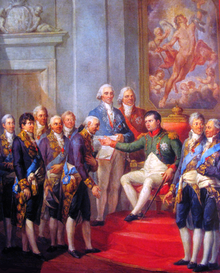
The Partitions of Poland were three partitions of the Polish–Lithuanian Commonwealth that took place toward the end of the 18th century and ended the existence of the state, resulting in the elimination of sovereign Poland and Lithuania for 123 years. The partitions were conducted by the Habsburg monarchy, the Kingdom of Prussia, and the Russian Empire, which divided up the Commonwealth lands among themselves progressively in the process of territorial seizures and annexations.

Frederick Augustus I was a member of the House of Wettin who reigned as the last Elector of Saxony from 1763 to 1806 and as the first King of Saxony from 1806 to 1827. He was also Duke of Warsaw from 1807 to 1815, a short-lived disputed Grand Duke of Lithuania in 1812, and a legitimate candidate to the Polish throne.
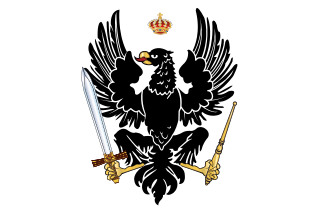
The Kingdom of Prussia constituted the German state of Prussia between 1701 and 1918. It was the driving force behind the unification of Germany in 1866 and was the leading state of the German Empire until its dissolution in 1918. Although it took its name from the region called Prussia, it was based in the Margraviate of Brandenburg. Its capital was Berlin.
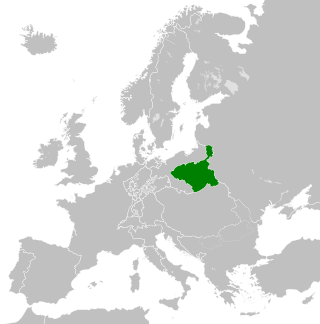
The Duchy of Warsaw, also known as the Grand Duchy of Warsaw and Napoleonic Poland, was a French client state established by Napoleon Bonaparte in 1807, during the Napoleonic Wars. It initially comprised the ethnically Polish lands ceded to France by Prussia under the terms of the Treaties of Tilsit, and was augmented in 1809 with territory ceded by Austria in the Treaty of Schönbrunn. It was the first attempt to re-establish Poland as a sovereign state after the 18th-century partitions and covered the central and southeastern parts of present-day Poland.

Congress Poland or Congress Kingdom of Poland, formally known as the Kingdom of Poland, was a polity created in 1815 by the Congress of Vienna as a semi-autonomous Polish state, a successor to Napoleon's Duchy of Warsaw. It was established when the French ceded a part of Polish territory to the Russian Empire following France's defeat in the Napoleonic Wars. In 1915, during World War I, it was replaced by the German-controlled nominal Regency Kingdom until Poland regained independence in 1918.
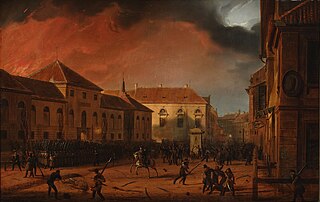
The November Uprising (1830–31), also known as the Polish–Russian War 1830–31 or the Cadet Revolution, was an armed rebellion in the heartland of partitioned Poland against the Russian Empire. The uprising began on 29 November 1830 in Warsaw when young Polish officers from the military academy of the Army of Congress Poland revolted, led by Lieutenant Piotr Wysocki. Large segments of the peoples of Lithuania, Belarus, and Right-bank Ukraine soon joined the uprising. Although the insurgents achieved local successes, a numerically superior Imperial Russian Army under Ivan Paskevich eventually crushed the uprising. The Russian Emperor Nicholas I issued the Organic Statute in 1832, according to which, henceforth Russian-occupied Poland would lose its autonomy and become an integral part of the Russian Empire. Warsaw became little more than a military garrison, and its university closed.
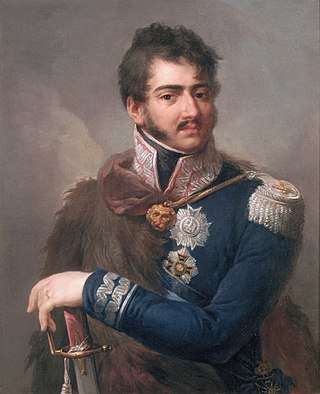
Prince Józef Antoni Poniatowski was a Polish general, minister of war and army chief, who became a Marshal of the French Empire during the Napoleonic Wars.

The Free, Independent, and Strictly Neutral City of Cracow with its Territory, more commonly known as the Free City of Cracow, and the Republic of Cracow, was a city republic created by the Congress of Vienna in 1815, which included the Polish city of Cracow (Kraków) and its surrounding areas.

The Treaties of Tilsit, also collectively known as the Peace of Tilsit, were two peace treaties signed by French Emperor Napoleon in the town of Tilsit in July 1807 in the aftermath of his victory at Friedland, at the end of the War of the Fourth Coalition. The first was signed on 7 July, between Napoleon and Russian Emperor Alexander I, when they met on a raft in the middle of the Neman river. The second was signed with Prussia on 9 July. The treaties were made at the expense of King Frederick William III of Prussia, who had already agreed to a truce on 25 June after the Grande Armée had captured Berlin and pursued him to the easternmost frontier of his realm.

The War of the Fourth Coalition was a war spanning 1806–1807 that saw a multinational coalition fight against Napoleon's French Empire, subsequently being defeated. The main coalition partners were Prussia and Russia with Saxony, Sweden, and Great Britain also contributing. Excluding Prussia, some members of the coalition had previously been fighting France as part of the Third Coalition, and there was no intervening period of general peace. On 9 October 1806, Prussia declared war on France and joined a renewed coalition, fearing the rise in French power after the defeat of Austria and establishment of the French-sponsored Confederation of the Rhine in addition to having learned of French plans to cede Prussian-desired Hanover to Britain in exchange for peace. Prussia and Russia mobilized for a fresh campaign with France, massing troops in Saxony.

Count Stanisław Małachowski, of the Nałęcz coat-of-arms was a Polish statesman, the first Prime Minister of Poland, a member of the Polish government's Permanent Council (1776–1780), Marshal of the Crown Courts of Justice from 1774, Crown Grand Referendary (1780–1792) and Marshal of the Four-Year Sejm (1788–1792).

Greater Poland uprising of 1806 was a Polish military insurrection which occurred in the region of Wielkopolska, also known as Greater Poland, against the occupying Prussian forces after the Partitions of the Polish–Lithuanian Commonwealth (1772–1795).
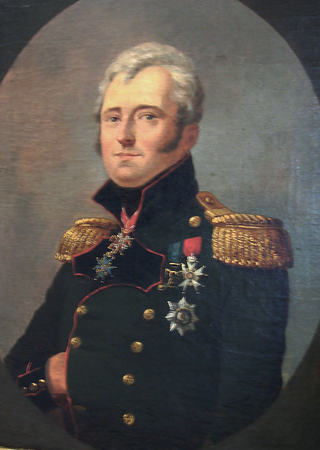
Józef Sowiński (1777–1831) was a Polish artillery general and a hero of Poland's November 1830 Uprising.

The Polish Legions were several Polish military units that served with the French Army in the Napoleonic era, mainly from 1797 to 1803, although some units continued to serve until 1815.
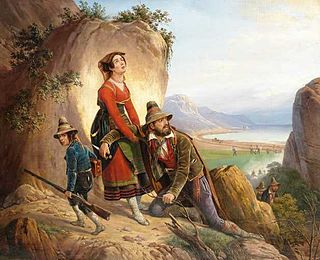
There were many resistance movements in partitioned Poland between 1795 and 1918. Although some of the szlachta was reconciled to the end of the Polish–Lithuanian Commonwealth in 1795, the possibility of Polish independence was kept alive by events within and without Poland throughout the 19th century. Poland's location on the North European Plain became especially significant in a period when its neighbours, the Kingdom of Prussia and Russia were intensely involved in European rivalries and alliances and modern nation states took form over the entire continent.

New Galicia or West Galicia was an administrative region of the Habsburg monarchy, constituted from the territory annexed in the course of the Third Partition of Poland in 1795.

Polish–French relations are relations between the nations of Poland and France, which date back several centuries.

Maria Augusta Nepomucena Antonia Francisca Xaveria Aloysia of Saxony was Princess of Saxony. Between 1791 and 1795, she played a political role as the potential successor to the Polish throne. She was considered a potential heir to the Duchy of Warsaw in 1807-1813.

Sejm of the Duchy of Warsaw was the parliament of the Duchy of Warsaw. It was created in 1807 by Napoleon, who granted a new constitution to the recently created Duchy. It had limited competences, including having no legislative initiative. It met three times: for regular sessions in 1809 and 1811, and for an extraordinary session in 1812. In the history of Polish parliament, it succeeded the Sejm of the Polish-Lithuanian Commonwealth and was followed by the Sejm of the Congress Poland.

The Army of the Duchy of Warsaw refers to the military forces of the Duchy of Warsaw. The Army was significantly based on the Polish Legions; it numbered about 30,000 and was expanded during wartime to almost 100,000. It was composed of infantry with a strong cavalry force supported by artillery. The Napoleonic customs and traditions resulted in some social tensions, but are generally credited with helpful modernization and useful reforms.
